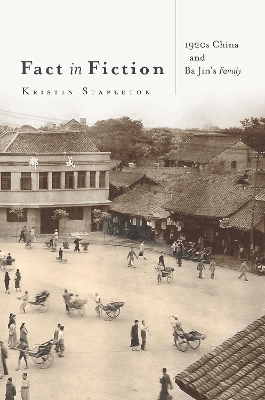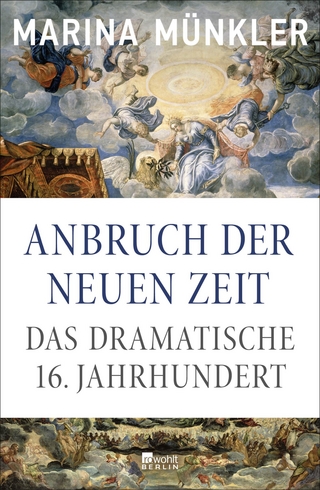
Fact in Fiction
Stanford University Press (Verlag)
978-1-5036-0106-2 (ISBN)
Stapleton's attention to historical evidence and clear prose that directly addresses themes and characters from Family create a book that scholars, students, and general readers will enjoy. She focuses on Chengdu, China, Ba Jin's birthplace and the setting for Family, which was also a cultural and political center of western China. The city's richly preserved archives allow Stapleton to create an intimate portrait of a city that seemed far from the center of national politics of the day but clearly felt the forces of—and contributed to—the turbulent stream of Chinese history.
Kristin Stapleton is Associate Professor of History at the University at Buffalo, State University of New York. She is also the author of Civilizing Chengdu: Chinese Urban Reform, 1895–1937 (2000) and a member of the National Committee on United States–China Relations.
Contents and AbstractsIntroduction: Ba Jin's Fiction and Twentieth-Century Chinese History chapter abstractThe introduction outlines the book's goals: to use Ba Jin's Turbulent Stream trilogy—especially the first novel, Family—as a springboard to analysis of social change in a West China city during the May Fourth era and to take a critical look at Ba Jin's interpretations of the society and world in which he grew up. Included is a biographical sketch of Ba Jin, an explanation of the significance of his fiction in shaping the conventional narrative of the May Fourth era, and an overview of the major themes of subsequent chapters: patriarchy and the "Confucian" family and the May Fourth critiques of them, the physical transformations that accompanied urban reform in Chinese cities in the first decades of the twentieth century, the nature of militarist politics in the 1910s through the 1930s, and the effects of warfare and political insecurity on the city and the families in it.
1Mingfeng: The Life of a Chinese Slave Girl chapter abstractThis chapter analyzes the social status of slave girls in early twentieth-century China based on archival evidence from Chengdu, among other sources. It demonstrates that, although late-Qing legal reforms attempted to abolish the status, slave girls continued to be bought and sold throughout the 1920s and 1930s. A local example of a slave girl contract is examined. This chapter includes a discussion of how slave girls experienced the city as they were brought from their villages and introduced into the households of the wealthy. The challenge of understanding the worldview of slave girls, given the limitations of historical sources, is raised in conjunction with an evaluation of Ba Jin's depiction of Mingfeng, a central character in Family. It ends with an assessment of the social movement to abolish slave girl status in the first half of the twentieth century and a discussion of the reasons for its failure.
2The Patriarch: Chengdu's Gentry chapter abstractThis chapter focuses on the social world of Chengdu's elite men. The sources of elite status and the impact on elites of political events surrounding the fall of the Qing dynasty in 1911 are both discussed. The chapter describes the walled compounds within which Chengdu's wealthy extended families lived with their servants, as well as the teahouses and other more public venues where the men met their friends and patronized the arts. The chapter presents evidence that Chengdu's gentry accepted many influences from abroad, including Western medical knowledge, while most remained committed to classical Chinese learning and the family rituals that Ba Jin condemned in Turbulent Stream. In addition to many other sources on elite Chengdu life, the chapter draws on numerous sources on elite Chengdu life, including the diary of Wu Yu, a prominent May Fourth critic of neo-Confucianism who lived most of his life in Chengdu.
3Juexin's City: The Chengdu Economy chapter abstractThis chapter assesses the state of the economy of Sichuan and Chengdu in the early 1920s, showing how political instability in the decade after the collapse of the Qing led to concentration of land in the hands of militarists, a rise in opium production, and a lack of investment in industry. Nevertheless, the city was a productive place and employed thousands of workers in various trades. The economic condition of such laborers is assessed with the help of sociological data collected at the time. With the backing of militarists who controlled the city, a few substantial development projects were launched, including a commercial street modeled on Shanghai's Nanjing Road. The chapter discusses the position that Ba Jin's eldest brother (the model for Turbulent Stream's Gao Juexin) held in Chengdu's commercial arcade and emphasizes the role that family ties played in the Chengdu economy.
4Sedan-Chair Bearers, Beggars, Actors, and Prostitutes: The Worlds of the Urban Poor chapter abstractThis chapter discusses the images of poor people Ba Jin presents in Turbulent Stream and then explores how poverty was understood and explained in early twentieth-century China. In Chengdu, the late-Qing period saw the establishment of new state-run institutions within which the poor were disciplined. In the political turbulence of the early Republic, these institutions declined and philanthropy came under the management of prominent gentry. The chapter also assesses what can be learned about the lives of the poor in Chengdu during the May Fourth period, including the housing available to them, the prevalence of disease, and opportunities for mobility. Turbulent Stream includes subplots involving prostitutes and actors, and this chapter discusses their status in 1920s Chengdu in comparison with conditions in Shanghai, which have been studied more extensively.
5Students, Soldiers, and Warlords: Protest and Warfare in the City chapter abstractThis chapter surveys the history of warfare in Chengdu and the attitudes of warlords toward student activism. Ba Jin lived through several battles in the city, and his experiences are reflected in Family. This chapter explains why control over the city was disputed so frequently in the 1910s and 1920s and describes the most significant impacts of instability. Several of the key militarist commanders in Chengdu are profiled, and their roles in encouraging or suppressing social and cultural change during the May Fourth era are assessed. Because they wanted to recruit educated young supporters, most of them presented themselves as progressive, something Ba Jin's fiction only hints at. The chapter ends with reflections on the lives of common soldiers via a critical discussion of a fictional diary of a Chengdu conscript that was published in the magazine Eastern Miscellany (Dongfang zazhi) in the 1920s.
6Qin: Chengdu and the "New Woman" chapter abstractThis chapter discusses women's education and roles in 1920s Chengdu, with insights from scholarship that challenges the May Fourth image of the "traditional woman." The debates over women's status in eastern-based periodicals were known in Chengdu, and a few women—including Ba Jin's contemporary Hu Lanqi—resisted arranged marriages and sought new employment opportunities. But most women would have found it very difficult to establish autonomy in 1920s Chengdu, given the lack of economic development and the frequent warfare. Political instability led to the rise of the Gowned Brothers, a semi-secret organization that offered some security in Chengdu's neighborhoods. Gowned Brother lodges tended to be culturally conservative, leading them to intimidate elite women who ventured into public life. This chapter examines the case of Cihai editor Shu Xincheng, a visiting instructor in Chengdu who was accused of corrupting girl students.
7Juehui: Revolution, Reform, and Development in Chengdu chapter abstractThis chapter examines revolutionary and reformist currents during the May Fourth period. It discusses how Chengdu people learned about and reacted to the May Fourth incident. Ba Jin's early introduction to anarchism is explored before the chapter turns to the history of Nationalist and Communist recruitment in Chengdu. Sichuan natives at the center of the Nationalist and Communist movements—Zhang Qun, Dai Jitao, and Wu Yuzhang—were sent to Chengdu to build those parties, but had little success. The chapter discusses the appeal of the Chinese Youth Party within Sichuan, but argues that party politics were less significant than in eastern China. Nevertheless, reformist trends were introduced to Chengdu, including the literacy movement launched by Yan Yangchu. The promise of urban planning to bring economic development appealed to some of Chengdu's militarists, and it was promoted by activists such as Lu Zuofu, who later founded the Minsheng Industrial Company.
Epilogue: Family and City in China's Twentieth-Century Revolutions chapter abstractThe epilogue sums up the central argument of the book that the attack on the patriarchal family that features so prominently in Ba Jin's Turbulent Stream trilogy and in narratives of the May Fourth/New Culture movement, while important, was not central to the lived experiences of most people in Chengdu in the 1920s. Political instability and warfare shaped people's lives by depressing the economy and opening a space for a powerful conservative movement, as well as for more radical ideas. Among social activists, however, urban development was viewed as a more promising route to a more progressive future than trying to change well-established social patterns. The epilogue also reflects on the decline of interest in urban development in the Mao years after 1949 and the revival of this theme in the years after his death.
| Erscheinungsdatum | 26.08.2016 |
|---|---|
| Zusatzinfo | 21 halftones, 2 tables, 2 maps |
| Verlagsort | Palo Alto |
| Sprache | englisch |
| Maße | 152 x 229 mm |
| Themenwelt | Geschichte ► Allgemeine Geschichte ► Neuzeit (bis 1918) |
| Geisteswissenschaften ► Geschichte ► Hilfswissenschaften | |
| Geisteswissenschaften ► Geschichte ► Regional- / Ländergeschichte | |
| Geisteswissenschaften ► Sprach- / Literaturwissenschaft ► Anglistik / Amerikanistik | |
| Geisteswissenschaften ► Sprach- / Literaturwissenschaft ► Literaturwissenschaft | |
| ISBN-10 | 1-5036-0106-4 / 1503601064 |
| ISBN-13 | 978-1-5036-0106-2 / 9781503601062 |
| Zustand | Neuware |
| Haben Sie eine Frage zum Produkt? |
aus dem Bereich


